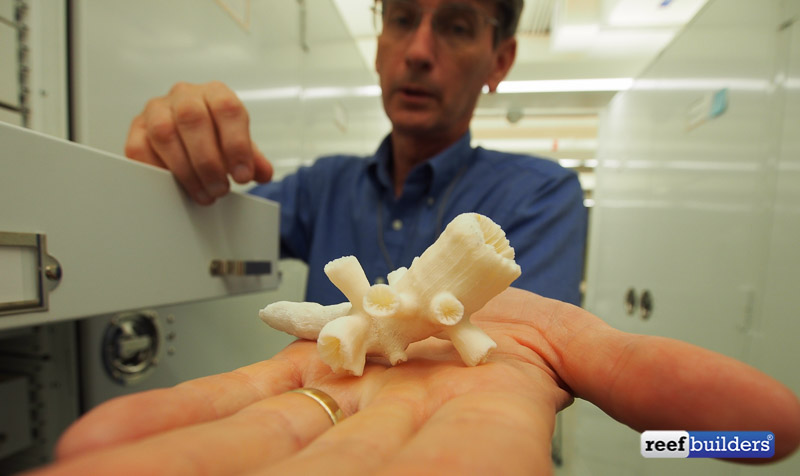Aquarists spend the majority of their coral-keeping career looking at, staring at, and growing live corals, hopefully. This is the inverse case for coral taxonomists such as Dr. Stephen Cairns who studies the remains of corals as skeletons, and all of the features that are visible without tissue.
There’s something to be said for both ways of looking at corals, frankly we prefer to see living corals, but when it comes to rare and unknown deepwater corals, we’ll take what we can get. So when the opportunity arose to take a tour behind the scenes of the Smithsonian Institution’s collection of stony corals, we jumped on it.

Our host for diving into the Smithsonian’s collection of stony coral (Scleractinia) skeletons, the largest in the world, was none other than Dr. Stephen Cairns. He is currently the curator of this collection, and the world’s foremost expert on Azooxanthellate stony corals, and an authority on Stylaster corals as well.
We knew that the visit to the world’s largest collection of stony corals would include many Azoox skeletons, most of which we’d never seen in person, and it was a real treat to be able to ask Dr. Cairns specific questions about all of them. What we didn’t expect was to see some shallow water stony corals that we’ve only seen in books or pictures.
The type specimens for two unusual Acropora including Acropora teres and Acropora cardenae were excpetionally cool to see in real life. We’ve seen pictures of both of these species before, but holding the samples in our hands was so much more informative, where we could observe how thin and delicate Acropora cardenae really is, and how smooth Acropora teres is.


Some other exciting surprises that we spotted at the Smithsonian include one of the deepest living Azoox coral species currently known, Letepsammia formosissima. What makes Letepsammia unique is that it lives below the carbonate compensation depth of 4000 to 5000 meters, so it has to fight the effects of cold water and high pressure that dissolves calcium carbonate – to combat its skeleton dissolving outright Letepsammia has a skeleton which is so porous that you can see through it!
Another really neat species that we were presented with is Turbinolia, the smallest living stony coral currently known which grows to just a few millimeters long. Interestingly, Turbinolia is actually found in relatively shallow water in tens of meters deep, but it is so small that you wouldn’t just happen to see it living in sand without specifically looking for it.

We only spent about two hours looking through the various cabinets holding the most diverse assemblage of stony corals anywhere in the world, but we could return and spend a week looking at each and every specimen, and we just might. Seeing such exotic coral skeletons of Javania, Rhizotrochus, Balanophyllia and Flabellum was pretty overwhelming, and we’d love to return to take it all in.
Big thanks to Dr. Cairns for taking some time to show us a few hundred stony coral bones, and answering our many questions. Be sure to scroll down and check out the full gallery of the many coral skeletons we photographed.







